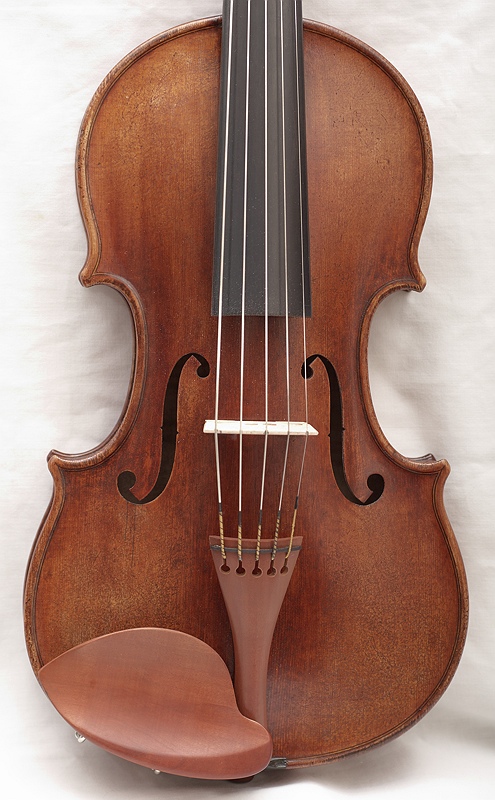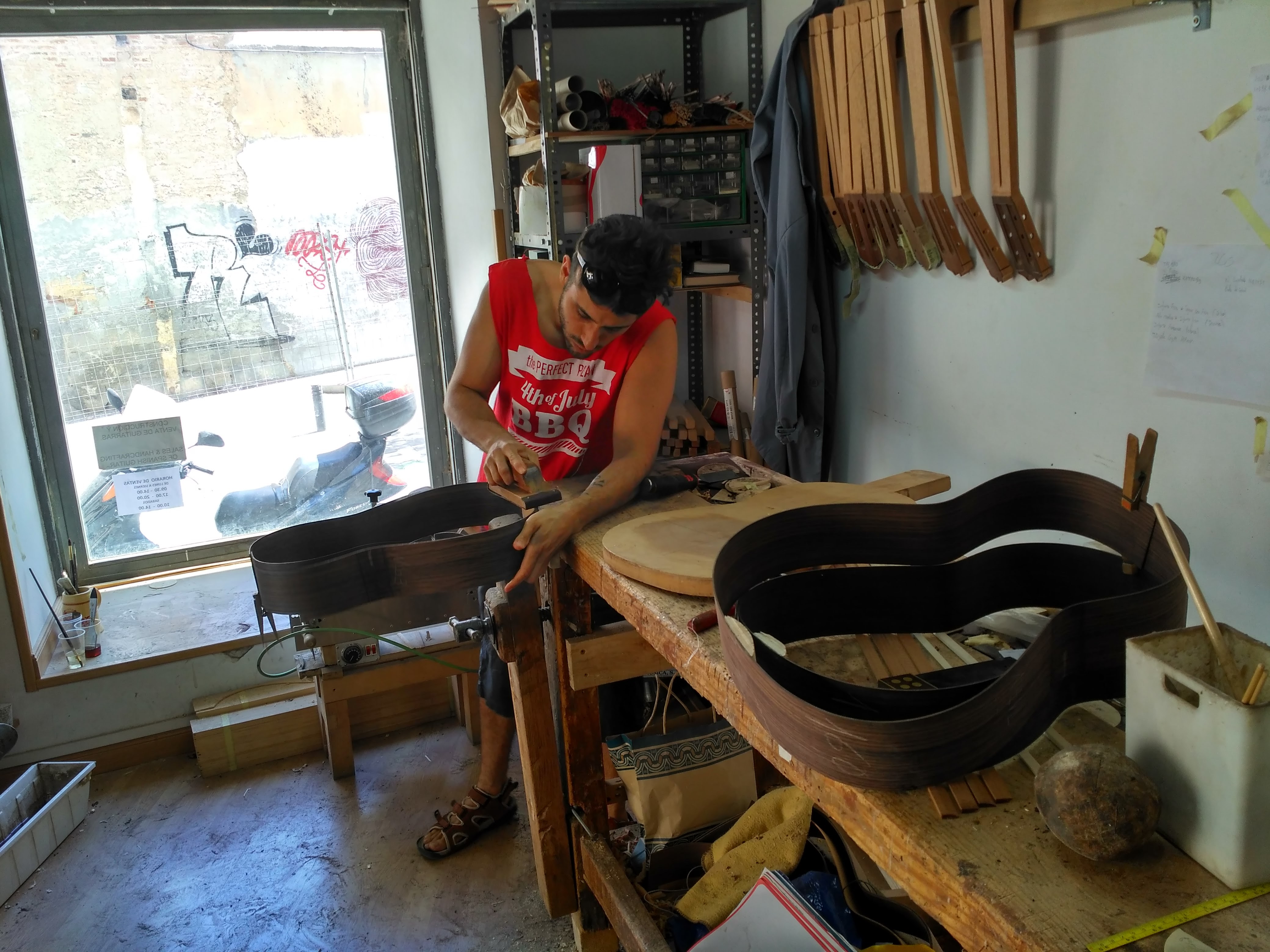|
Five-string Violin
A five-string violin is a variant of violin with an extra string tuned below the violin's usual range. In addition to the G, D, A, and E strings of a standard violin, a five-string violin typically includes a lower C string. Violins with 6 or more strings may add a low F, low B♭, low E♭, or a soprano violin high A (sometimes a high B). The five-string violin was created to combine the pitch ranges of the violin and viola. Bobby Hicks, a noted bluegrass fiddler, popularized the five-string violin in 1963, first showcasing his modification during a performance in Las Vegas. José Herrando, wrote 6 Sonatas for the 5 string Violin (or 5 string Viola aka Grand Viola, or Viola Pomposa) and continuo. Due to the size limitations of a five-string violin, the low C string typically resonates with a slightly softer sound than the other strings. Five-string violas (aka Viola pomposa), normally tuned C, G, D, and A, and adding a high E string, have in the same tuning, but on a viola bod ... [...More Info...] [...Related Items...] OR: [Wikipedia] [Google] [Baidu] |
Violin
The violin, sometimes referred to as a fiddle, is a wooden chordophone, and is the smallest, and thus highest-pitched instrument (soprano) in regular use in the violin family. Smaller violin-type instruments exist, including the violino piccolo and the pochette (musical instrument), pochette, but these are virtually unused. Most violins have a hollow wooden body, and commonly have four strings (music), strings (sometimes five-string violin, five), usually tuned in perfect fifths with notes G3, D4, A4, E5, and are most commonly played by drawing a bow (music), bow across the strings. The violin can also be played by plucking the strings with the fingers (pizzicato) and, in specialized cases, by striking the strings with the wooden side of the bow (col legno). Violins are important instruments in a wide variety of musical genres. They are most prominent in the Western classical music, Western classical tradition, both in ensembles (from chamber music to orchestras) and as solo ... [...More Info...] [...Related Items...] OR: [Wikipedia] [Google] [Baidu] |
Viola
The viola ( , () ) is a string instrument of the violin family, and is usually bowed when played. Violas are slightly larger than violins, and have a lower and deeper sound. Since the 18th century, it has been the middle or alto voice of the violin family, between the violin (which is tuned a perfect fifth higher) and the cello (which is tuned an octave lower). The strings from low to high are typically tuned to C3, G3, D4, and A4. In the past, the viola varied in size and style, as did its names. The word ''viola'' originates from the Italian language. The Italians often used the term '' viola da braccio'', meaning, literally, 'of the arm'. "Brazzo" was another Italian word for the viola, which the Germans adopted as ''Bratsche''. The French had their own names: ''cinquiesme'' was a small viola, ''haute contre'' was a large viola, and ''taile'' was a tenor. Today, the French use the term ''alto'', a reference to its range. The viola was popular in the heyday of five-part ... [...More Info...] [...Related Items...] OR: [Wikipedia] [Google] [Baidu] |
Bobby Hicks
Robert Caldwell Hicks (July 21, 1933 – August 16, 2024) was a Grammy Award-winning American bluegrass fiddler and musician with more than fifty years of experience. He was inducted into the International Bluegrass Music Hall of Fame in 2017. Life and career Hicks was born in Newton, North Carolina, and learned to play the fiddle before he was 9 years old. He attended several fiddlers conventions and at the age of eleven, he won the North Carolina State Championship playing the tune " Black Mountain Rag". He joined Jim Eanes's band in the early 1950s. In 1953, bluegrass festival organizer Carlton Haney introduced Hicks to Bill Monroe, who hired him as a bass player. He first recorded with the Bluegrass Boys on December 31, 1954, by which time he had switched to fiddle. During this period, he learned to play "Nashville swing" by the session fiddler Dale Potter, a style Hicks often used when playing with Bill Monroe on the road. Monroe dubbed Hicks ''"the truest fiddler he had e ... [...More Info...] [...Related Items...] OR: [Wikipedia] [Google] [Baidu] |
José Herrando
José Herrando (Valencia, c. 1720/1721-Madrid, 1763) was a Spanish violinist and composer. Career Herrando was a friend of the writer and mathematician Diego de Torres Villarroel and a fixed musician for some theater companies in Madrid, for which he composed several pieces, such as for the comedy ''Manos blancas no ofenden'' (White hands do not offend) by Pedro Calderón de la Barca. He spent some time in the service of the Duke of Arcos theater, to which he dedicated his ''Arte y puntual explicación del modo de tocar el violín con perfección y facilidad'' (Art and timely explanation of how to play the violin with perfection and ease) published in Paris in 1756. This was the first published attempt by a Spaniard at teaching this instrument. Its front featured an engraving by Carmona with his portrait. Herrando was first violinist for the Royal Chapel of the Incarnation when, in 1754 he wrote ''Seis sonatinas para violín de cinco cuerdas y bajo armónico, no cifrado'' (Six ... [...More Info...] [...Related Items...] OR: [Wikipedia] [Google] [Baidu] |
Viola Pomposa
__NOTOC__ The viola pomposa (also known as the violino pomposo) is a five-stringed Viola developed around 1725. There are no exact dimensions applicable to all instruments used under this name, although in general the pomposa is slightly wider than a standard viola (hence the Italian adjective "pomposa"). It uses four viola strings, tuned conventionally (C-G-D-A), with the addition of a high E string (usually a violin string), giving it a greater range than the orchestral viola; the trade-off comes in a sound which is slightly more resonant than a violin. The viola pomposa is played on the arm and has a range from C3 to A6 (or even higher) with fingered notes. Using harmonics, the range can be extended to C8 depending on the quality of the strings. The viola pomposa should not be confused with the viola da spalla, the violoncello, or the violoncello piccolo (read Paulinyi, 2012.Zoltan Paulinyi, Sobre o desuso e ressurgimento da viola pomposa.' Belo Horizonte: Per Musi, UFMG, v.25, ... [...More Info...] [...Related Items...] OR: [Wikipedia] [Google] [Baidu] |
Luthier
A luthier ( ; ) is a craftsperson who builds or repairs string instruments. Etymology The word ' is originally French and comes from ''luth'', the French word for "lute". The term was originally used for makers of lutes, but it came to be used in French for makers of most bowed and plucked stringed instruments such as members of the violin family (including violas, cellos, and double basses) and guitars. Luthiers, however, do not make harps or pianos; these require different skills and construction methods because their strings are secured to a frame. Craft The craft of luthiers, lutherie (rarely called "luthiery", but this often refers to stringed instruments other than those in the violin family), is commonly divided into the two main categories of makers of stringed instruments that are plucked or strummed and makers of stringed instruments that are bowed. Since bowed instruments require a bow, the second category includes a subtype known as a bow maker or archetier ... [...More Info...] [...Related Items...] OR: [Wikipedia] [Google] [Baidu] |
Pegbox
A variety of methods are used to tune different stringed instruments. Most change the pitch produced when the string is played by adjusting the tension of the strings. A tuning peg in a pegbox is perhaps the most common system. A peg has a grip or knob on it to allow it to be turned. A tuning pin is a tuning peg with a detachable grip, called a tuning lever. The socket on the tuning lever fits over the pin and allows it to be turned. Tuning pins are used on instruments where there is no space for a knob on each string, such as pianos and harps. Turning the peg or pin tightens or loosens the string. Some tuning pegs and pins are tapered, some threaded. Some tuning pegs are ornamented with shell, metal, or plastic inlays, beads (pips) or rings. Other tuning systems include screw-and-lever tuners, geared tuners, and the konso friction tuning system (using braided leather rings). Pegbox or headstock A pegbox is the part of certain stringed musical instruments (the violin ... [...More Info...] [...Related Items...] OR: [Wikipedia] [Google] [Baidu] |
Fiddling
A fiddle is a bowed string musical instrument, most often a violin or a bass. It is a colloquial term for the violin, used by players in all genres, including classical music. Although in many cases violins and fiddles are essentially synonymous, the style of the music played may determine specific construction differences between fiddles and classical violins. For example, fiddles may optionally be set up with a bridge with a flatter arch to reduce the range of bow-arm motion needed for techniques such as the double shuffle, a form of bariolage involving rapid alternation between pairs of adjacent strings. To produce a ''brighter'' tone than the deep tones of gut or synthetic core strings, fiddlers often use steel strings. The fiddle is part of many traditional (folk) styles, which are typically aural traditions—taught " by ear" rather than via written music. Fiddling is the act of playing the fiddle, and fiddlers are musicians who play it. Among musical styles, fiddl ... [...More Info...] [...Related Items...] OR: [Wikipedia] [Google] [Baidu] |
Swing Music
Swing music is a style of jazz that developed in the United States during the late 1920s and early 1930s. It became nationally popular from the mid-1930s. Swing bands usually featured soloists who would improvise on the melody over the arrangement. The danceable swing style of big bands and bandleaders such as Benny Goodman was the dominant form of American popular music from 1935 to 1946, known as the swing era, when people were dancing the Lindy Hop. The verb "to swing (jazz performance style), swing" is also used as a term of praise for playing that has a strong groove (music), groove or drive. Musicians, who were also big-band leader of the swing, era include Benny Goodman, Duke Ellington, Count Basie, Jimmie Lunceford, Cab Calloway, Benny Carter, Jimmy Dorsey, Tommy Dorsey, Earl Hines, Bunny Berigan, Harry James, Lionel Hampton, Glenn Miller, Artie Shaw. Overview Swing has its roots in 1920s dance music Musical ensemble, ensembles, which began using new styles of written ar ... [...More Info...] [...Related Items...] OR: [Wikipedia] [Google] [Baidu] |
Jazz
Jazz is a music genre that originated in the African-American communities of New Orleans, Louisiana, in the late 19th and early 20th centuries. Its roots are in blues, ragtime, European harmony, African rhythmic rituals, spirituals, hymns, marches, vaudeville song, and dance music. Since the 1920s Jazz Age, it has been recognized as a major form of musical expression in traditional and popular music. Jazz is characterized by swing and blue notes, complex chords, call and response vocals, polyrhythms and improvisation. As jazz spread around the world, it drew on national, regional, and local musical cultures, which gave rise to different styles. New Orleans jazz began in the early 1910s, combining earlier brass band marches, French quadrilles, biguine, ragtime and blues with collective polyphonic improvisation. However, jazz did not begin as a single musical tradition in New Orleans or elsewhere. In the 1930s, arranged dance-oriented swing big bands, ... [...More Info...] [...Related Items...] OR: [Wikipedia] [Google] [Baidu] |







